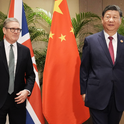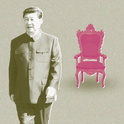The Chinese Communist Party is aiming to consolidate its rule by lionising Mao’s legacy. Photo: Damien Farrell
Down a dusty road in a remote far eastern suburb of Beijing a revolutionary-themed restaurant is busy preparing for the party of the year. Friday, 1st July, marks the Chinese Communist Party’s (CCP) 90th anniversary and The East is Red is expecting diners to run into the hundreds.
They will come ravenous not just for the hearty cuisine but also for a heavy dose of communist nostalgia. A twice-daily show—ramped up for the anniversary —includes revolution-era songs, dance and drama, cherry picked from the chaotic days of the 1966-76 cultural revolution.
I visit on a Tuesday evening, and despite the mid-week timing and isolated location the restaurant is around half full. The imposing doorway to the cavernous building is a colossal red star—inside are stirring statues of revolutionary heroes, murals of workers clutching Mao’s Little Red Book and an army of performers dressed in Red Guard uniforms.
This is a family day out. Every customer, down to the smallest child, waves a red flag and many sway in the aisles to songs such as “Sing in Praise of the Motherland.” Across one wall gigantic red Chinese characters spell out the words: “May the Chinese Communist Party live ten thousand, 100 million years.”
Every morning and afternoon this week Zhang Nanfang, a 26-year old waitress at The East is Red (the Chinese name translates directly as "Red Classics Theme Restaurant") practices the revolutionary dance moves she will perform on Friday. For Zhang, who has her hair carefully braided with red ribbons and the mandatory six Mao Zedong badges pinned to her chest, the occasion marks an opportunity to celebrate the “Great Helmsman,” as he is commonly known here.
“As the national leader who founded our nation, Mao is quite great. He made mistakes in the cultural revolution, but after all he did save China,” she quips as we pick at a vast spicy vat of tofu. For Zhang, The East is Red has been an education. “Before I came to work here, I had no idea about the quotations from Chairman Mao. And I’d never heard of "Fight the landlord" (an expression referring to the denouncement and criticism of landowners during the cultural revolution); but here we can act it out in dances with costumes.” She adds, smiling shyly, “it’s pretty authentic history.”
As one might expect, the restaurant does not touch on tragedies such as Mao’s 1958 Great Leap Forward and the resulting Great Famine: a disaster that claimed approximately 30m Chinese lives. When asked, Zhang had only vaguely heard of the catastrophe.
As China continues to hurtle headlong into capitalism, the Communist party (the CCP) is, ironically, aiming to consolidate its rule by lionising Mao’s legacy. Membership of the party is growing: last year numbers reached over 80m—more than the populations of Britain, New Zealand and Portugal combined. And in an effort to fortify the country’s founding fable even further, the regime has encouraged a feverish reinstatement of “Red values” across the nation.
Nowhere is this more apparent than in Chongqing, a sprawling metropolis of over 30m people situated on the banks of the river Yangtze. Bo Xilai, Chongqing’s ambitious local party secretary, has kick-started an aggressive Red revival since he took power in 2007. This year, the revival has reached fever pitch with a “Red songs” campaign designed to celebrate the CCP’s anniversary—and further Bo’s aspirations to enter the politburo in 2012. State newspapers have been ordered to print the nationalistic song lyrics and popular TV dramas have been axed to make way for an orgy of patriotic broadcasting. Zhang Guozuo, director of the Center for Chinese Soft Power Studies, was quoted in the Chongqing Daily News saying that the songs are about “the glorious history, awe-inspiring righteousness and harmony of the nation. This is great pioneering work aimed at consolidating Chinese ideology and strengthening the cultural power of our country.”
It is not only revolutionary songs and restaurants that are receiving a boost in the build up to the anniversary. This year, China CYTS Tours is tapping into—and capitalising on—renewed Red fever with its newly-launched Long March “Red tour.” As described in a glossy brochure, tourists can follow in the footsteps of the soldiers or the Red Army, who marched across China’s vast hinterland in 1934-5. The tour offers an opportunity to dress up in Red Army uniforms, sing Red Army songs and eat Red Army meals to “recall the bitterness and think about the sweetness” of the journey that marked the beginning of Mao’s ascent to power. Highlights include reenactments of battles, with tourists divided into groups to attack and occupy hilltop fortresses. Many older citizens sign up as a way to reminisce about a bygone era.
China’s younger generation is not exempt. According to the tour company, the government-backed Long March tour is filled largely with students and workers forced into attending by party branches within their universities or work units.
“Young people nowadays are accepting philosophies and values from the west. Our ruling party thinks that our young people, our citizens, need another education and the 90th anniversary of the party is a very good opportunity,” explains Yu En, China CYTS Tour’s assistant general manager, when we meet in the company’s slick Beijing office.
Above all, red tourism means big bucks. From 1995 to 2010 visitor numbers to the Jinggang mountains, known as the birthplace of the Red Army, increased 20-fold according to the state-run China Daily. Last year alone, income in the region exceeded 3bn yuan, or around half the local GDP.
For the government, the drive has a double benefit. Firstly, to rejuvenate poor, landlocked areas marked by the revolution by cashing in on Mao’s mythical status. More importantly, Red tourism promotes national unification and stability by propagating a golden past.
Not everyone is convinced. Ed Jocelyn, the owner of a China-based tourism company Red Rock Treks & Expeditions and author of The Long March, believes that the drive betrays little more than commercial greed and ideological pandering. “Red tourism diverts resources into vanity projects which have no long-term value,” he says. “The idea came as a means of encouraging tourism into some very poor and little-known areas, but once it got taken up at a national level it became little more than a propaganda exercise.”
For many, however, the revival is not only a touchstone for China’s past but a shining light for its future. Back in The East is Red, I chat to Huo Jinglin, 68, a comely retired teacher eating with three generations of her family.
“Coming here feels like having a politics lesson,” says Huo, who only wishes the restaurant was in a closer, more convenient, downtown area, so she could visit more often. “For the next generation it’s an education in patriotism. Red tours and restaurants are very, very necessary. China went through so many dynasties and wars. Only the CCP saved China and founded a new nation.”
As we get up to leave after the show, and waiters clear up the remaining tables heaving with leftover food and spilled beer, Huo gestures towards the now deflated dining hall filled just minutes earlier with rapturous revolutionary fever. “Our nation has gained a higher and higher status in the world,” she announces. “Now we Chinese have a lot of money in our pockets. But we’ve come here not just to consume. We mostly want to feel China’s great achievements.”
Additional reporting by Wan Quan
Down a dusty road in a remote far eastern suburb of Beijing a revolutionary-themed restaurant is busy preparing for the party of the year. Friday, 1st July, marks the Chinese Communist Party’s (CCP) 90th anniversary and The East is Red is expecting diners to run into the hundreds.
They will come ravenous not just for the hearty cuisine but also for a heavy dose of communist nostalgia. A twice-daily show—ramped up for the anniversary —includes revolution-era songs, dance and drama, cherry picked from the chaotic days of the 1966-76 cultural revolution.
I visit on a Tuesday evening, and despite the mid-week timing and isolated location the restaurant is around half full. The imposing doorway to the cavernous building is a colossal red star—inside are stirring statues of revolutionary heroes, murals of workers clutching Mao’s Little Red Book and an army of performers dressed in Red Guard uniforms.
This is a family day out. Every customer, down to the smallest child, waves a red flag and many sway in the aisles to songs such as “Sing in Praise of the Motherland.” Across one wall gigantic red Chinese characters spell out the words: “May the Chinese Communist Party live ten thousand, 100 million years.”
Every morning and afternoon this week Zhang Nanfang, a 26-year old waitress at The East is Red (the Chinese name translates directly as "Red Classics Theme Restaurant") practices the revolutionary dance moves she will perform on Friday. For Zhang, who has her hair carefully braided with red ribbons and the mandatory six Mao Zedong badges pinned to her chest, the occasion marks an opportunity to celebrate the “Great Helmsman,” as he is commonly known here.
“As the national leader who founded our nation, Mao is quite great. He made mistakes in the cultural revolution, but after all he did save China,” she quips as we pick at a vast spicy vat of tofu. For Zhang, The East is Red has been an education. “Before I came to work here, I had no idea about the quotations from Chairman Mao. And I’d never heard of "Fight the landlord" (an expression referring to the denouncement and criticism of landowners during the cultural revolution); but here we can act it out in dances with costumes.” She adds, smiling shyly, “it’s pretty authentic history.”
As one might expect, the restaurant does not touch on tragedies such as Mao’s 1958 Great Leap Forward and the resulting Great Famine: a disaster that claimed approximately 30m Chinese lives. When asked, Zhang had only vaguely heard of the catastrophe.
As China continues to hurtle headlong into capitalism, the Communist party (the CCP) is, ironically, aiming to consolidate its rule by lionising Mao’s legacy. Membership of the party is growing: last year numbers reached over 80m—more than the populations of Britain, New Zealand and Portugal combined. And in an effort to fortify the country’s founding fable even further, the regime has encouraged a feverish reinstatement of “Red values” across the nation.
Nowhere is this more apparent than in Chongqing, a sprawling metropolis of over 30m people situated on the banks of the river Yangtze. Bo Xilai, Chongqing’s ambitious local party secretary, has kick-started an aggressive Red revival since he took power in 2007. This year, the revival has reached fever pitch with a “Red songs” campaign designed to celebrate the CCP’s anniversary—and further Bo’s aspirations to enter the politburo in 2012. State newspapers have been ordered to print the nationalistic song lyrics and popular TV dramas have been axed to make way for an orgy of patriotic broadcasting. Zhang Guozuo, director of the Center for Chinese Soft Power Studies, was quoted in the Chongqing Daily News saying that the songs are about “the glorious history, awe-inspiring righteousness and harmony of the nation. This is great pioneering work aimed at consolidating Chinese ideology and strengthening the cultural power of our country.”
It is not only revolutionary songs and restaurants that are receiving a boost in the build up to the anniversary. This year, China CYTS Tours is tapping into—and capitalising on—renewed Red fever with its newly-launched Long March “Red tour.” As described in a glossy brochure, tourists can follow in the footsteps of the soldiers or the Red Army, who marched across China’s vast hinterland in 1934-5. The tour offers an opportunity to dress up in Red Army uniforms, sing Red Army songs and eat Red Army meals to “recall the bitterness and think about the sweetness” of the journey that marked the beginning of Mao’s ascent to power. Highlights include reenactments of battles, with tourists divided into groups to attack and occupy hilltop fortresses. Many older citizens sign up as a way to reminisce about a bygone era.
China’s younger generation is not exempt. According to the tour company, the government-backed Long March tour is filled largely with students and workers forced into attending by party branches within their universities or work units.
“Young people nowadays are accepting philosophies and values from the west. Our ruling party thinks that our young people, our citizens, need another education and the 90th anniversary of the party is a very good opportunity,” explains Yu En, China CYTS Tour’s assistant general manager, when we meet in the company’s slick Beijing office.
Above all, red tourism means big bucks. From 1995 to 2010 visitor numbers to the Jinggang mountains, known as the birthplace of the Red Army, increased 20-fold according to the state-run China Daily. Last year alone, income in the region exceeded 3bn yuan, or around half the local GDP.
For the government, the drive has a double benefit. Firstly, to rejuvenate poor, landlocked areas marked by the revolution by cashing in on Mao’s mythical status. More importantly, Red tourism promotes national unification and stability by propagating a golden past.
Not everyone is convinced. Ed Jocelyn, the owner of a China-based tourism company Red Rock Treks & Expeditions and author of The Long March, believes that the drive betrays little more than commercial greed and ideological pandering. “Red tourism diverts resources into vanity projects which have no long-term value,” he says. “The idea came as a means of encouraging tourism into some very poor and little-known areas, but once it got taken up at a national level it became little more than a propaganda exercise.”
For many, however, the revival is not only a touchstone for China’s past but a shining light for its future. Back in The East is Red, I chat to Huo Jinglin, 68, a comely retired teacher eating with three generations of her family.
“Coming here feels like having a politics lesson,” says Huo, who only wishes the restaurant was in a closer, more convenient, downtown area, so she could visit more often. “For the next generation it’s an education in patriotism. Red tours and restaurants are very, very necessary. China went through so many dynasties and wars. Only the CCP saved China and founded a new nation.”
As we get up to leave after the show, and waiters clear up the remaining tables heaving with leftover food and spilled beer, Huo gestures towards the now deflated dining hall filled just minutes earlier with rapturous revolutionary fever. “Our nation has gained a higher and higher status in the world,” she announces. “Now we Chinese have a lot of money in our pockets. But we’ve come here not just to consume. We mostly want to feel China’s great achievements.”
Additional reporting by Wan Quan












